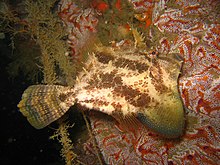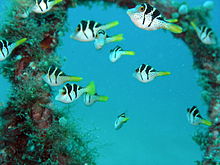Filefish
| Filefish | ||||||||||||
|---|---|---|---|---|---|---|---|---|---|---|---|---|

White-spotted filefish ( Cantherhines macrocerus ) |
||||||||||||
| Systematics | ||||||||||||
|
||||||||||||
| Scientific name | ||||||||||||
| Monacanthidae | ||||||||||||
| Bonaparte , 1846 |
The filefish (Monacanthidae) are a family from the order of the puffer fish relatives (Tetraodontiformes) and comprise over 100 species in about 26 genera .
Most species predominantly inhabit coral reefs in the tropical seas. Other species, such as those of the genera Paramonacanthus , Thamnaconus and Stephanolepis , live in sea grass meadows and rocky reefs . Some species also live in subtropical and temperate seas.
features
Filefish, like the triggerfish , to which they are closely related, have "inherited" a dorsal spine mechanism (which fixes the first spine upright with the second shorter one) - but usually the second is already too weak or missing completely, and with the ventral spine the situation is similar: the fish do not spread themselves into crevices and the like. Their teeth (three instead of four in the front of the upper jaw) are not as strong as those of the triggerfish. Their body color and pattern allow them to adapt to their surroundings and thus escape the eyes of their enemies. The mimicry filefish ( Paraluteres prionurus ) mimics the body color and shape of the poisonous saddle-headed pufferfish ( Canthigaster valentini ).
The smallest representative is Rudarius minutus with a length of up to five centimeters, the largest is the script filefish ( Aluterus scriptus ) with a length of up to 1.10 meters.
All have a small terminal mouth and eat crabs, worms, small fish and algae. The two species of the genus Oxymonacanthus only eat polyps from hard corals of the genus Acropora .
Reproduction
The reproduction has so far only been observed in a few filefish species. Most species spawn on the bottom. In many cases, the spawn is guarded by one or both sexes. In the seagrass filefish , which was first bred in the aquarium in 2007, only the female guards the clutch and also chases away the male. The monogamous pallet spines ( Oxymonacanthus ) spawn in clumps of algae and then no longer care about the clutch.
| Phylogenetic systematics of filefish according to McCord & Westneat 2015: | |||||||||||||||||||||||||||||||||||||||||||||||||||||||||||||||||||||||||||||||||||||||||||||||||||||||||||||||||||||||||||||||||||||||
|---|---|---|---|---|---|---|---|---|---|---|---|---|---|---|---|---|---|---|---|---|---|---|---|---|---|---|---|---|---|---|---|---|---|---|---|---|---|---|---|---|---|---|---|---|---|---|---|---|---|---|---|---|---|---|---|---|---|---|---|---|---|---|---|---|---|---|---|---|---|---|---|---|---|---|---|---|---|---|---|---|---|---|---|---|---|---|---|---|---|---|---|---|---|---|---|---|---|---|---|---|---|---|---|---|---|---|---|---|---|---|---|---|---|---|---|---|---|---|---|---|---|---|---|---|---|---|---|---|---|---|---|---|---|---|---|
|
|||||||||||||||||||||||||||||||||||||||||||||||||||||||||||||||||||||||||||||||||||||||||||||||||||||||||||||||||||||||||||||||||||||||
Systematics
Filefish belong to the pufferfish relatives (Tetraodontiformes) and together with their sister group , the triggerfish (Balistidae), form the suborder Balistoidei. In older publications they are often still listed as the subfamily Monacanthinae among the triggerfish.
There are about 26 genera and over 100 species. This makes the filefish the second-richest family of puffer fish relatives after the puffer fish.









- Genus Acanthaluteres Bleeker, 1865
- Acanthaluteres brownii (Richardson, 1846)
- Acanthaluteres spilomelanurus (Quoy & Gaimard, 1824)
- Acanthaluteres vittiger (Castelnau, 1873)
- Genus Acreichhys Fraser-Brunner, 1941
- Acreichhys hajam (Bleeker, 1851)
- Acreichhys radiatus (Popta, 1900)
- Seagrass filefish ( Acreichhys tomentosus ) (Linnaeus, 1758)
- Genus Aluterus Cloquet, 1816
- Aluterus heudelotii Hollard, 1855
- Unicorn filefish ( Aluterus monoceros ) (Linnaeus, 1758)
- Aluterus schoepfii (Walbaum, 1792)
- Script filefish ( Aluterus scriptus ) (Osbeck, 1765)
- Genus Amanses Gray, 1835
- Amanses scopas (Cuvier, 1829)
- Genus Anacanthus Gray, 1830
- Anacanthus barbatus Gray, 1830
- Genus Brachaluteres Bleeker, 1865
- Brachaluteres fahaqa Clark & Gohar, 1953
- Brachaluteres jacksonianus (Quoy & Gaimard, 1824)
- Brachaluteres taylori Woods in Schultz et al., 1966
- Brachaluteres ulvarum Jordan & Fowler, 1902
- Genus Cantherhines Swainson, 1839
- Cantherhines cerinus Randall, 2011
- Yellowtail Filefish ( Cantherhines dumerili ) (Hollard, 1854)
- Cantherhines fronticinctus (Günther, 1867)
- Cantherhines longicaudus Hutchins & Randall, 1982
- White-spotted filefish ( Cantherhines macrocerus ) (Hollard in Guichenot, 1853)
- Cantherhines multilineatus (Tanaka, 1918) (also included in the genus Thamnaconus )
- Cantherhines nukuhiva Randall, 2011
- Net filefish ( Cantherhines pardalis ) (Rüppell, 1837)
- Cantherhines pullus (Ranzani, 1842)
- Cantherhines rapanui (de Buen, 1963)
- Cantherhines sandwichiensis (Quoy & Gaimard, 1824)
- Cantherhines tiki Randall, 1964
- Cantherhines verecundus (Jordan, 1925)
- Genus Cantheschenia Hutchins, 1977
- Cantheschenia grandisquamis Hutchins, 1977
- Cantheschenia longipinnis (Fraser-Brunner, 1941)
- Genus Chaetodermis Swainson, 1839
- Ornamental filefish ( Chaetodermis penicilligerus ) (Cuvier, 1816)
- Genus Colurodontis Hutchins, 1977
- Colurodontis paxmani Hutchins, 1977
- Genus Enigmacanthus Hutchins, 2002
- Enigmacanthus filamentosus Hutchins, 2002
- Genus Eubalichthys Whitley, 1930
- Eubalichthys bucephalus (Whitley, 1931)
- Eubalichthys caeruleoguttatus Hutchins, 1977
- Eubalichthys cyanoura Hutchins, 1987
- Eubalichthys gunnii (Günther, 1870)
- Eubalichthys mosaicus (Ramsay & Ogilby, 1886)
- Eubalichthys quadrispinus Hutchins, 1977
- Genus Lalmohania Hutchins, 1994
- Lalmohania velutina Hutchins, 1994
- Genus Meuschenia Whitley, 1929
- Meuschenia australis (Donovan, 1824)
- Meuschenia flavolineata Hutchins, 1977
- Meuschenia freycineti (Quoy & Gaimard, 1824)
- Meuschenia galii (Waite, 1905)
- Meuschenia hippocrepis (Quoy & Gaimard, 1824)
- Meuschenia scaber (Forster in Bloch & Schneider, 1801)
- Meuschenia trachylepis (Günther, 1870)
- Meuschenia venusta Hutchins, 1977
- Genus Monacanthus Oken, 1817
- Chinese fan belly ( Monacanthus chinensis ) (Osbeck, 1765)
- Monacanthus ciliatus (Mitchill, 1818)
- Slender Filefish ( Monacanthus tuckeri ) Bean, 1906
- Genus Nelusetta Whitley, 1939
- Nelusetta ayraud (Quoy & Gaimard, 1824)
- Genus Oxymonacanthus Bleeker, 1865
- Red Sea Pallet Filefish ( Oxymonacanthus halli ) Marshall, 1952
- Pallet filefish ( Oxymonacanthus longirostris ) (Bloch & Schneider, 1801)
- Genus Paraluteres Bleeker, 1865
- Paraluteres arqat Clark & Gohar, 1953
- Mimicry filefish ( Paraluteres prionurus ) (Bleeker, 1851)
- Genus Paramonacanthus Bleeker, 1865
- Paramonacanthus arabicus Hutchins, 1997
- Paramonacanthus choirocephalus (Bleeker, 1851)
- Paramonacanthus cryptodon (Bleeker, 1855)
- Paramonacanthus curtorhynchos (Bleeker, 1855)
- Paramonacanthus filicauda (Günther, 1880)
- Paramonacanthus frenatus (Peters, 1855)
- Paramonacanthus japonicus (Tilesius, 1809)
- Paramonacanthus lowei Hutchins, 1997
- Paramonacanthus matsuurai Hutchins, 1997
- Paramonacanthus nematophorus (Günther, 1870)
- Paramonacanthus nipponensis (Kamohara, 1939)
- Paramonacanthus oblongus (Temminck & Schlegel, 1850)
- Paramonacanthus otisensis Whitley, 1931
- Paramonacanthus pusillus (Rüppell, 1829)
- Paramonacanthus sulcatus (Hollard, 1854)
- Paramonacanthus tricuspis (Hollard, 1854)
- Genus Pervagor Whitley, 1930
- Yellow-eyed filefish ( Pervagor alternans ) (Ogilby, 1899)
- Orange-tail filefish ( Pervagor aspricaudus ) (Hollard, 1854)
- Cave filefish ( Pervagor janthinosoma ) (Bleeker, 1854)
- Pervagor marginalis Hutchins, 1986
- Black-headed filefish ( Pervagor melanocephalus ) (Bleeker, 1853)
- White line filefish ( Pervagor nigrolineatus ) (Herre, 1927)
- Pervagor randalli Hutchins, 1986
- Hawaiian filefish ( Pervagor spilosoma ) (Lay & Bennett, 1839)
- Genus Pseudalutarius Bleeker, 1865
- Pseudalutarius nasicornis (Temminck & Schlegel, 1850)
- Genus Pseudomonacanthus Bleeker, 1865
- Pseudomonacanthus elongatus Fraser-Brunner, 1940
- Pseudomonacanthus macrurus (Bleeker, 1856)
- Peron's filefish ( Pseudomonacanthus peroni ) (Hollard, 1854)
- Genus Rudarius Jordan & Fowler, 1902
- Rudarius ercodes Jordan & Fowler, 1902
- Rudarius excelsus Hutchins, 1977
- Small filefish ( Rudarius minutus ) Tyler, 1970
- Genus Scobinichthys Whitley, 1931
- Scobinichthys granulatus (White, 1790)
- Genus Stephanolepis Gill, 1861
- Stephanolepis auratus (Castelnau, 1861)
- Stephanolepis cirrhifer (Temminck & Schlegel, 1850)
- Stephanolepis diaspros Fraser-Brunner, 1940
- Stephanolepis hispidus (Linnaeus, 1766)
- Stephanolepis setifer (Bennett, 1831)
- Genus Thamnaconus Smith, 1949
- Thamnaconus analis (Waite, 1904)
- Thamnaconus arenaceus (Barnard, 1927)
- Thamnaconus degeni (Regan, 1903)
- Thamnaconus fajardoi Smith, 1953
- Thamnaconus fijiensis Hutchins & Matsuura, 1984
- Thamnaconus garretti (Fowler, 1928)
- Thamnaconus hypargyreus (Cope, 1871)
- Thamnaconus melanoproctes (Boulenger, 1889)
- Thamnaconus modestoides (Barnard, 1927)
- Thamnaconus modestus (Günther, 1877)
- Thamnaconus paschalis (Regan, 1913)
- Thamnaconus septentrionalis (Günther, 1874)
- Thamnaconus striatus (Kotthaus, 1979)
- Thamnaconus tessellatus (Günther, 1880)
Aquarium keeping
In saltwater aquariums , the keeping of filefish is considered to be risky because they eat a large number of invertebrates. Some small filefish species, especially the seagrass filefish, which is coveted to eat the unloved glass roses and fire anemones , and some pervagor species can be kept in the coral reef aquarium. A minimum pool size of 300 to 500 liters is required. Attacks on corals only occur when the animals are insufficiently or incorrectly fed. All filefishes offered for the saltwater aquarium are wild-caught.
literature
- Joseph S. Nelson, Fishes of the World , John Wiley & Sons, 2006, ISBN 0-471-25031-7
- Robert A. Patzner / Horst Moosleitner: Mergus Sea Water Atlas Volume 6 Non-Perciformes , Mergus-Verlag, Melle, ISBN 3-88244-116-X
- Rudie H. Kuiter / Helmut Debelius : Atlas der Meeresfische , Kosmos-Verlag, 2006, ISBN 3-440-09562-2
Web links
- Filefish on Fishbase.org (English)
Individual evidence
- ↑ Gumanao GS, AR Bos & JE Randall: Seagrass Filefish Acreichthys tomentosus (Linneaus), a master of camouflage . In: Journal of the Ocean Science Foundation . 30, 2018, pp. 58-72.
- ↑ Iris Böning: Bred for the first time: the seagrass filefish . In Der MeerwasserAquarianer, specialist magazine for seawater aquaristics, 2/2008, Rüdiger Latka Verlag, ISSN 1432-1505
- ↑ Ellen Thaler : Lifelong loyalty, without any infidelities: Oxymonacanthus species . In KORALLE, marine aquaristic specialist magazine, No. 19 February / March 2003, Natur und Tier Verlag Münster, ISSN 1439-779X
- ↑ Charlene L. McCord, Mark W. Westneat: Phylogenetic relationships and the evolution of BMP4 in triggerfishes and filefishes (Balistoidea). Molecular Phylogenetics and Evolution, September 2015, doi: 10.1016 / j.ympev.2015.09.014
- ↑ Ellen Thaler: Recommended filefish for the reef aquarium . In KORALLE, marine aquarium specialist magazine, No. 19




